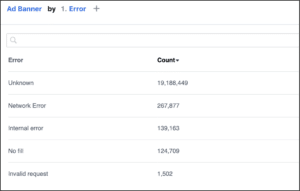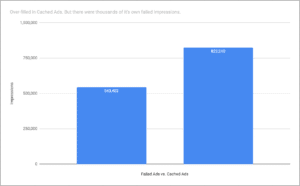Filling the Programmatic Void: An Innovative Approach to App Monetization

In 2018 my company started to see a change in the success of programmatic ads in our network of apps. We were losing money, and the decline was because we relied too heavily on programmatic ads for monetization. As advertisers ebb-and-flow among the programmatic ad marketplace, the price of advertising also ebbs-and-flows. In our case, there were not as many advertisers as there used to be. The decline of advertisers in the programmatic marketplace was negatively affecting our income.
As a team we knew we needed to find a way to get our numbers back up. We determined that much of our financial success was at the mercy of a network of advertisers that we have no communication with and limited control over (which is core to the foundation and security of the programmatic marketplace).
The company I work with, Salem Web Network, hosts the definitive largest faith-based audience online.
Our many brands, apps, and websites, combine to be in the multi-millions of users. Part of solely hosting such a large audience gives us the opportunity of providing targeted, custom marketing campaigns to our audience. These custom marketing campaigns are our Direct Sold campaigns.

We include our Direct Sold campaigns with the programmatic network ads in a sort of quasi-waterfall strategy. Think of our programmatic advertising in two separate columns.
- The network of programmatic advertisers (Amazon, Tide, Uber, Progressive, etc.)
- And, our in-house advertisers and Direct Sold campaigns (Salem Web Network brands, and partners)
The solution to our programmatic problem was in front of us the whole time. We just had to figure out how to leverage it. One of those columns we have very limited control over: that is, the programmatic network. While the other column we have broad control over: our Direct Sold campaigns. We can leverage those Direct Sold campaigns.
Once we realized we had some control over part of our programmatic problem, we started devising a creative solution to utilize the assets within our grasp. Our goal was and is to increase ad impressions and revenue. Of course like the good digital marketers we are, we found a way to do this backed by data. What we found in our data research along the way is very interesting.
There is a programmatic ad void.
We gathered analytics data that showed a large portion of ad impressions failing to deliver. This is due to internet connectivity issues, programmatic ad server issues, and specific device issues or settings that might prevent an ad from being displayed at the proper moment.

Failed Networks Ad Analytics Data
If you are doing things right when developing your programmatic ad units in an app, you should be preloading them. Or with a robust service like Mo-Pub, use the pre-cache feature. But even then we know that due to a multitude of reasons, some ads still won’t show. We have determined that if you run a DSP with a programmatic ad server, you are surely losing impressions to the void.
We set out to solve a big financial problem by solving a small technical problem. We wanted to find a way to serve an ad even when there is no internet connection, or when network ads simply fail to display. We built a machine of functions that serves an ad when the programmatic ad network fails to serve one. It’s essentially a small-scale programmatic ad server that lives in the app.
We call them Cached Ads.
Our developers worked on setting up a cache function in our apps to store an image and some text. Then with some JSON, we connected that cache to a platform for the marketing team to manage the campaigns within. Much like you would turn on/off a programmatic ad, the team could do the same with these “cached” ads.
Our Direct Sold ads are perfect for this platform because of the control we have over the assets. Our team has manual control over the delivery of our Direct Sold ads when a network ad won’t display.
Our network at Salem has an added benefit from this new feature. Not only can we ensure ad delivery, but our cached ads are outside the realm of the programmatic marketplace, which means bids don’t compete like they did before. Our Direct Sold ad campaigns are specifically built in-house to target our audience by interest and relevance. So the experience is still beneficial to the user and our Salem Web Network partners.
To help focus on the benefits of Cached Ads, let’s take a look at those columns in our programmatic ad strategy again.
- The network of programmatic advertisers (Amazon, Tide, Uber, Progressive, etc.)
- Our in-house advertisers and Direct Sold campaigns (Salem Web Network brands, and partners)
In regular use of our DSP, both of these columns have competing bids in the ad network marketplace. With the inclusion of our Cached Ads, network ads will continue to run. So, we will continue to get the income we expect plus income from cached ads.
 Cache Filled Ads Analytics Data
Cache Filled Ads Analytics Data
The benefit of Cached Ads is that we are filling network ad impressions in which there were none displayed regularly. Up until now, the user would just see a blank space and we miss out on money. Cached Ads always display and are an added benefit to our current programmatic strategy.
This may not be a standardized solution.
Programmatic ads aren’t guaranteed to grow income over-time. It is an easy way to monetize, but programmatic is no evergreen solution to growth because it’s based on bidding in the marketplace. There are plenty of other choices you can pick from to monetize your app, and maybe one of those is programmatic or perhaps you are exclusively running an in-house style of ad serving.
At Salem we have teams working to build partnerships with advertisers that would benefit our users. The inclusion of Cached Ads provides a proprietary system of ad delivery that no other DSP takes a part of. But like any agency, clients will come and go and it could be possible that those programmatic voids go unfilled.
If we are going to standardize constant ad serving we have to do it with the users in mind. No matter how you choose to serve an ad and monetize your app, you should always do your best to make sure it’s right for the user. Use ads when and where you need to, and even make them helpful and beneficial to the users. In our case, we are able to increase ad impressions and income, all while still making sure we serve the best ad for our audience.
Our Cached Ads platform is still undergoing version updates. We are consistently making improvements based on performance and initiatives. Reach out to me if you have feedback, I would love to hear from you.
I could not have succeeded in this project without my team of developers and marketers at Salem Web Network, so thank you all!









